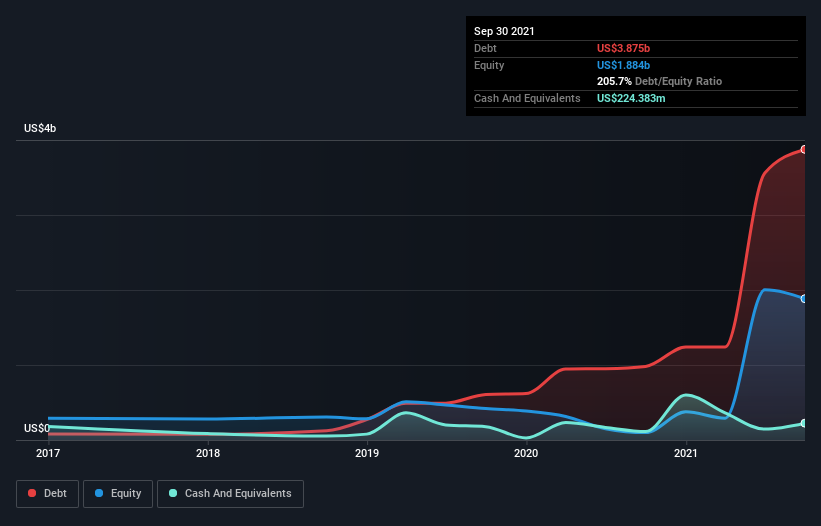- United States
- /
- Oil and Gas
- /
- NasdaqGS:NFE
Does New Fortress Energy (NASDAQ:NFE) Have A Healthy Balance Sheet?

Legendary fund manager Li Lu (who Charlie Munger backed) once said, 'The biggest investment risk is not the volatility of prices, but whether you will suffer a permanent loss of capital.' When we think about how risky a company is, we always like to look at its use of debt, since debt overload can lead to ruin. Importantly, New Fortress Energy Inc. (NASDAQ:NFE) does carry debt. But is this debt a concern to shareholders?
When Is Debt A Problem?
Debt assists a business until the business has trouble paying it off, either with new capital or with free cash flow. Part and parcel of capitalism is the process of 'creative destruction' where failed businesses are mercilessly liquidated by their bankers. While that is not too common, we often do see indebted companies permanently diluting shareholders because lenders force them to raise capital at a distressed price. Having said that, the most common situation is where a company manages its debt reasonably well - and to its own advantage. When we think about a company's use of debt, we first look at cash and debt together.
View our latest analysis for New Fortress Energy
What Is New Fortress Energy's Net Debt?
The image below, which you can click on for greater detail, shows that at September 2021 New Fortress Energy had debt of US$3.88b, up from US$980.9m in one year. On the flip side, it has US$224.4m in cash leading to net debt of about US$3.65b.

A Look At New Fortress Energy's Liabilities
We can see from the most recent balance sheet that New Fortress Energy had liabilities of US$767.9m falling due within a year, and liabilities of US$4.01b due beyond that. Offsetting this, it had US$224.4m in cash and US$176.7m in receivables that were due within 12 months. So it has liabilities totalling US$4.38b more than its cash and near-term receivables, combined.
This deficit is considerable relative to its market capitalization of US$4.73b, so it does suggest shareholders should keep an eye on New Fortress Energy's use of debt. This suggests shareholders would be heavily diluted if the company needed to shore up its balance sheet in a hurry.
We measure a company's debt load relative to its earnings power by looking at its net debt divided by its earnings before interest, tax, depreciation, and amortization (EBITDA) and by calculating how easily its earnings before interest and tax (EBIT) cover its interest expense (interest cover). The advantage of this approach is that we take into account both the absolute quantum of debt (with net debt to EBITDA) and the actual interest expenses associated with that debt (with its interest cover ratio).
New Fortress Energy shareholders face the double whammy of a high net debt to EBITDA ratio (23.5), and fairly weak interest coverage, since EBIT is just 0.63 times the interest expense. The debt burden here is substantial. One redeeming factor for New Fortress Energy is that it turned last year's EBIT loss into a gain of US$76m, over the last twelve months. When analysing debt levels, the balance sheet is the obvious place to start. But ultimately the future profitability of the business will decide if New Fortress Energy can strengthen its balance sheet over time. So if you're focused on the future you can check out this free report showing analyst profit forecasts.
Finally, a business needs free cash flow to pay off debt; accounting profits just don't cut it. So it is important to check how much of its earnings before interest and tax (EBIT) converts to actual free cash flow. During the last year, New Fortress Energy burned a lot of cash. While investors are no doubt expecting a reversal of that situation in due course, it clearly does mean its use of debt is more risky.
Our View
On the face of it, New Fortress Energy's interest cover left us tentative about the stock, and its conversion of EBIT to free cash flow was no more enticing than the one empty restaurant on the busiest night of the year. Having said that, its ability to grow its EBIT isn't such a worry. Overall, it seems to us that New Fortress Energy's balance sheet is really quite a risk to the business. So we're almost as wary of this stock as a hungry kitten is about falling into its owner's fish pond: once bitten, twice shy, as they say. When analysing debt levels, the balance sheet is the obvious place to start. However, not all investment risk resides within the balance sheet - far from it. We've identified 4 warning signs with New Fortress Energy (at least 1 which is potentially serious) , and understanding them should be part of your investment process.
If you're interested in investing in businesses that can grow profits without the burden of debt, then check out this free list of growing businesses that have net cash on the balance sheet.
Valuation is complex, but we're here to simplify it.
Discover if New Fortress Energy might be undervalued or overvalued with our detailed analysis, featuring fair value estimates, potential risks, dividends, insider trades, and its financial condition.
Access Free AnalysisHave feedback on this article? Concerned about the content? Get in touch with us directly. Alternatively, email editorial-team (at) simplywallst.com.
This article by Simply Wall St is general in nature. We provide commentary based on historical data and analyst forecasts only using an unbiased methodology and our articles are not intended to be financial advice. It does not constitute a recommendation to buy or sell any stock, and does not take account of your objectives, or your financial situation. We aim to bring you long-term focused analysis driven by fundamental data. Note that our analysis may not factor in the latest price-sensitive company announcements or qualitative material. Simply Wall St has no position in any stocks mentioned.
About NasdaqGS:NFE
New Fortress Energy
Operates as an integrated gas-to-power energy infrastructure company that provides energy and development services to end-users worldwide.
Fair value low.
Similar Companies
Market Insights
Community Narratives




